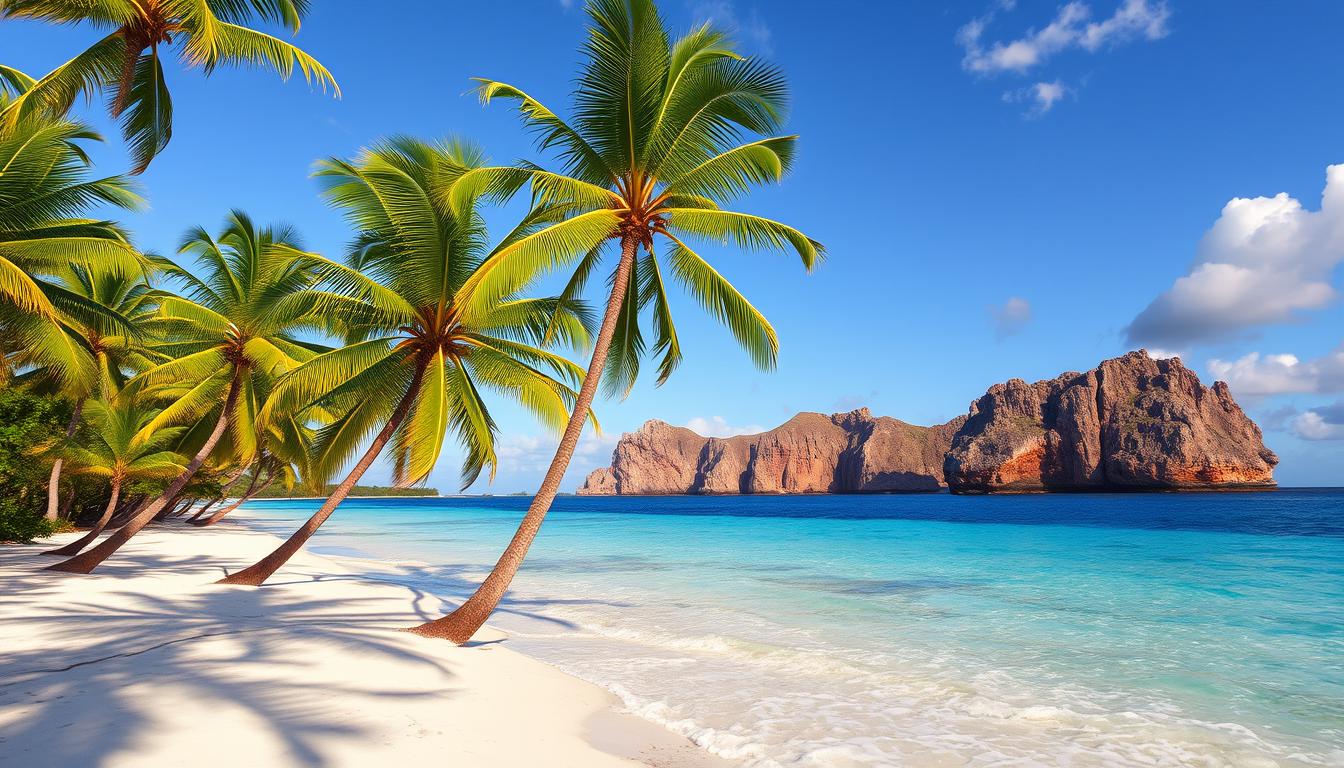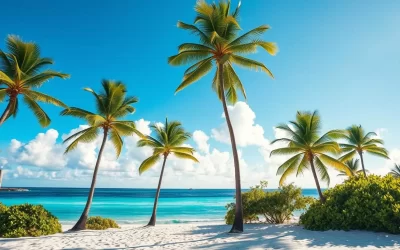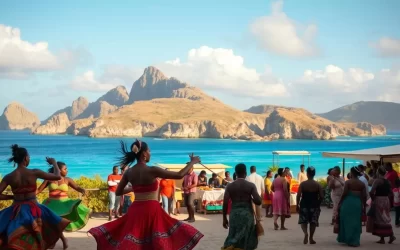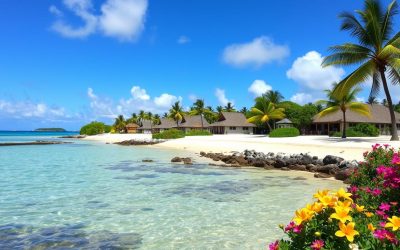✓ Accommodations ✓ Flights ✓ Rental Cars
Did you know that Nauru is the world’s smallest independent island nation, measuring just 8 square miles? Despite its tiny size, this Pacific gem packs a punch with its rich cultural legacy and unique history of phosphate mining.
When planning your visit, understanding the local currency and payment methods is crucial. This guide will help you navigate these essentials, ensuring a smooth and enjoyable trip. From managing money efficiently to exploring the island’s fascinating history, you’ll find everything you need to know right here.
Whether you’re drawn by its natural beauty or intrigued by its past, Nauru offers big experiences in a small package. Let’s dive into what makes this island a must-visit destination.
Discovering Nauru: An Island Overview
From its phosphate-rich past to its stunning reefs, this island is full of surprises. Its history and geography make it a unique destination for travelers seeking something extraordinary.
Historical Background and Phosphate Legacy
Once one of the wealthiest nations in the world, this island’s fortune came from phosphate mining. The mining boom transformed its landscape and economy. Today, remnants of this era are visible across the island, offering a glimpse into its prosperous past.
Hotels like the Odn Aiwo reflect this history, blending old-world charm with modern needs. On the other hand, the refined Ewa Lodge stands as a testament to the island’s evolving hospitality scene.
Geographical and Cultural Highlights
The island’s geography is as diverse as its history. Its reefs are a haven for marine life, making it a paradise for snorkelers and divers. The warm waters and vibrant coral formations are a must-see.
Cultural landmarks and historical sites add depth to your visit. From WWII relics to traditional villages, every corner tells a story. Staying at places like the Ewa Lodge allows you to immerse yourself in this rich tapestry.
Whether you’re exploring its natural beauty or delving into its past, this island promises an unforgettable experience.
Getting There: Transportation and Visa Requirements
Planning your trip to this remote island requires careful preparation, especially when it comes to transportation and visas. Limited flight options and specific entry requirements make it essential to plan ahead. Here’s what you need to know to ensure a smooth journey.
Flight Options from Australia and Beyond
Reaching this island involves navigating a small number of commercial flights. Nauru Airlines operates routes from Brisbane, Australia, as well as from Tarawa, Kiribati, and Nadi, Fiji. Flights from Majuro in the Marshall Islands are also available, making it a convenient hub for travelers in the Pacific region.
Due to limited schedules, booking your tickets early is highly recommended. Keep in mind that weather conditions or other disruptions can affect flight availability, so flexibility is key.

Visa Application Process and Entry Essentials
Securing a visa is a crucial step for your trip. Most travelers will need to apply for a tourist visa, which can take up to a month to process. It’s best to apply 1-2 months before your planned departure to avoid delays.
Citizens of certain countries, like the Marshall Islands, can obtain a visa on arrival. However, most visitors must go through the standard application process, which includes submitting necessary documents and paying a fee.
When traveling to remote destinations, it’s important to be prepared. Here are some practical tips:
- Carry enough cash, as credit card services are limited.
- Check weather conditions, especially during the cyclone season (November to April).
- If you plan to swim, stick to safe areas and follow local advice.
Understanding the proximity of neighboring regions like the Marshall Islands can also help you plan your journey more effectively. Whether you’re traveling by air or sea, these insights will make your trip smoother and more enjoyable.
Navigating the Island: Local Transport and Getting Around
Exploring this small country is an adventure in itself, with unique transportation options that make getting around both fun and practical. Whether you’re renting a vehicle, hopping on a scooter, or simply walking, you’ll find that this island nation is easy to navigate.
Rental Vehicles, Scooters, and Walking
Renting a car or scooter is a popular choice for visitors. The flat, 19km road that circles the country is perfect for cycling, and rentals are affordable at around $10 per day. Walking is another great option, especially in the compact town areas where you can soak in the local culture and music.
Local Transit Tips and Safety Considerations
If you prefer not to drive, taxis are readily available, especially near the airport and major hotels. Keep in mind that traffic control around the airport is unique, so follow local guidelines for a smooth experience. Here are some tips to stay safe and efficient:
- Carry cash, as credit card services are limited.
- Stick to designated paths when walking or cycling.
- Be mindful of weather conditions, especially during the wet season.
With these insights, you’ll be well-prepared to explore this island nation and enjoy its charm to the fullest.
Where to Stay: Accommodation Options in Nauru
Finding the right place to stay can make or break your travel experience. Whether you’re looking for budget-friendly options or luxurious retreats, this island offers a variety of choices to suit your needs. Here’s a detailed look at some of the best hotels and what you can expect during your stay.
Hotel Comparisons: Odn Aiwo, Menen, and Ewa Lodge
The Menen Hotel is a top choice for travelers seeking comfort and convenience. Located near the airport, it’s perfect for those with early or late flight schedules. The hotel offers spacious rooms, modern amenities, and a welcoming atmosphere.
For a more budget-friendly option, consider the Odn Aiwo. This hotel provides basic but comfortable accommodations, ideal for travelers who prefer to spend their time exploring rather than staying indoors. Its central location makes it easy to access local attractions.
If you’re looking for a blend of luxury and local charm, the Ewa Lodge is a great pick. Known for its personalized service and serene environment, it’s perfect for those who want a relaxing experience.
Budget Versus Luxury Room Choices
Budget hotels like Odn Aiwo offer essential amenities at affordable rates. These are ideal for travelers who prioritize trip activities over lavish stays. Rooms are cozy, and the focus is on practicality.
On the other hand, luxury options like the Menen Hotel and Ewa Lodge provide more spacious rooms, premium amenities, and exceptional service. These are perfect for those who want to indulge during their stay.
When planning your trip, consider your priorities. If you’re here for the experience of the island itself, a budget hotel might suffice. But if comfort and relaxation are key, splurging on a luxury stay could enhance your journey.
Where to Eat: Best Dining Experiences on the Island
Exploring the island’s culinary scene is a journey in itself, blending flavors and traditions in unique ways. From beachside eateries to cozy restaurants, every meal here tells a story of culture and history.
Local Cuisine and Must-Try Dishes
The island’s food culture is deeply influenced by its phosphate-rich past. Many dishes feature imported ingredients, reflecting the island’s reliance on external sources. Yet, local chefs have mastered the art of creating flavorful meals that highlight the island’s unique identity.
One standout is the Chinese restaurant at the Odn Aiwo Hotel. Known for its authentic flavors, it’s a favorite among both locals and visitors. Another must-visit is the Bay Restaurant, which offers a fusion of international and local dishes. Its beachfront location adds to the charm, making it a perfect spot for a memorable meal.
Here are some must-try dishes:
- Seafood platters: Fresh catches from the surrounding waters.
- Local curries: A blend of spices and imported ingredients.
- Fusion desserts: A sweet end to your meal with a tropical twist.
Beachside Dining and Scenic Views
Dining by the beach is an experience you won’t want to miss. The sound of waves and the gentle breeze create a relaxing atmosphere. Many restaurants offer outdoor seating, allowing you to enjoy the stunning views while savoring your meal.
The Bay Restaurant is a prime example, offering both great food and a picturesque setting. Whether you’re enjoying a romantic dinner or a casual lunch, the beachside ambiance enhances the experience.
The Influence of Phosphate Mining on Dining
The island’s phosphate mining legacy has indirectly shaped its dining landscape. With limited arable land, the island relies heavily on imported food. This has led to a diverse culinary scene, blending local traditions with international flavors.
Despite these challenges, the food business continues to evolve. Local chefs are finding innovative ways to create dishes that reflect the island’s heritage while embracing modern trends.
Practical Tips for Dining Safely
When dining out, it’s important to keep a few things in mind:
- Carry cash: Many places don’t accept credit cards.
- Check reviews: Look for highly recommended spots to ensure a great experience.
- Stay hydrated: Opt for bottled water to avoid any health issues.
Exploring the island’s dining scene is a delightful adventure. From beachside meals to unique fusion dishes, every bite offers a taste of the island’s rich culture and history.
Adventures and Activities: Exploring Nauru’s Attractions
Adventure awaits on this small island, where history and nature collide. Whether you’re hiking through rugged trails or diving into crystal-clear waters, there’s no shortage of excitement. This section will guide you through the best activities to make your trip unforgettable.
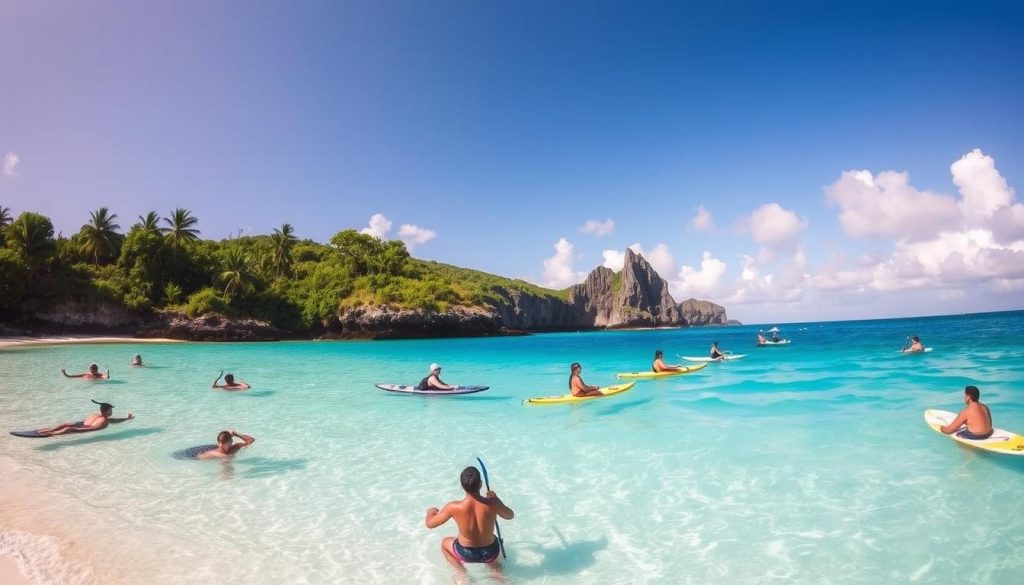
Hiking Trails and WWII Relics
One of the most popular activities is hiking the Bomber Track. This trail takes you through lush landscapes and offers a glimpse into the island’s WWII history. Along the way, you’ll encounter relics like old bunkers and aircraft remains, adding a historical twist to your adventure.
For a more relaxed experience, explore the island’s other trails. These paths are perfect for soaking in the natural beauty and learning about the local flora and fauna. After a day of hiking, unwind in a cozy room at one of the island’s hotels.
Water Sports and Beach Experiences
If you love the ocean, you’re in for a treat. The island’s beaches are ideal for snorkeling, kayaking, and paddleboarding. The vibrant coral reefs and marine life make every dive an unforgettable experience.
For a more laid-back day, relax on the sandy shores or enjoy a meal at a beachside restaurant. Many of these spots offer stunning views, making them perfect for a sunset dinner. Whether you’re seeking thrills or tranquility, the island’s beaches have it all.
Balancing adventure with relaxation is key to making the most of your trip. After a day of exploring, treat yourself to a comfortable room and a delicious meal at a local restaurant. This way, you can recharge and get ready for your next adventure.
Exploring History and Culture in Nauru
Dive into the heart of this tiny nation’s past, where every corner tells a story of resilience and transformation. From its rise as one of the wealthiest countries in the country world to its challenges today, this island’s history is both fascinating and complex. Whether you’re a history buff or a curious traveler, exploring its museums, war relics, and heritage sites offers a deeper understanding of its unique identity.
Museums, War Relics, and Heritage Sites
Begin your journey by visiting the island’s museums, which showcase artifacts and exhibits that trace its history. These spaces provide a window into the island’s phosphate mining era, which once made it one of the richest nations in the country world. You’ll also find displays highlighting its cultural traditions and the impact of colonialism.
War relics are another must-see. Sites like Command Ridge, a WWII lookout point, offer a glimpse into the island’s strategic role during the war. Disused pillboxes and artillery pieces still dot the landscape, serving as silent reminders of a turbulent past. These relics not only tell a compelling story but also connect you to the island’s broader global history.
The Phosphate Legacy and Cultural Evolution
The phosphate industry played a pivotal role in shaping this nation. At its peak, revenues from mining were estimated at AUD$100–120 million annually. This wealth transformed the island, but the depletion of resources has left a lasting impact. Today, remnants of this era, such as abandoned mining equipment, are part of the island’s heritage.
Cultural highlights are equally captivating. Traditional dances, music, and crafts reflect the island’s rich heritage. Visiting local villages allows you to experience these traditions firsthand. As you explore, you’ll see how the island’s history and culture have evolved, creating a unique blend of old and new.
“To understand this island is to walk through its past, where every step reveals a story of resilience and adaptation.”
Immerse yourself in the historical context that defines this destination. Whether you’re marveling at war relics or learning about the phosphate boom, your travel experience will be enriched by these insights. This small island may be remote, but its stories are anything but ordinary.
Natural Beauty and Outdoor Experiences
The natural beauty of this island is a hidden gem waiting to be explored. From pristine beaches to vibrant reefs, the outdoor experiences here are unforgettable. Whether you’re a nature enthusiast or just looking to unwind, this island offers something for every person.
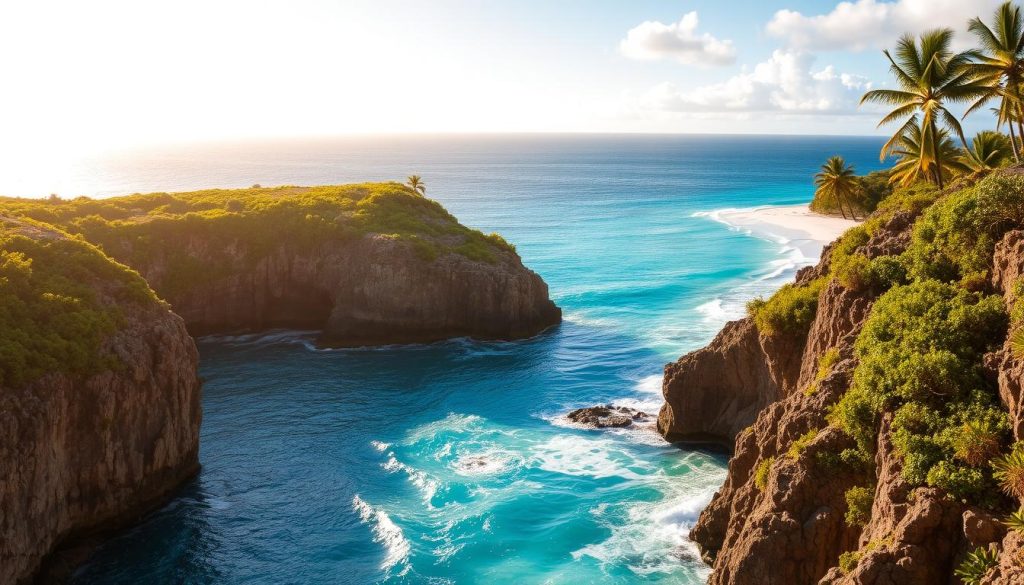
Scenic Spots, Beaches, and Reefs
One of the highlights of this island is its stunning beaches. The soft sand and clear waters make it a perfect spot for relaxation. For those who love adventure, the reefs are a must-see. They are teeming with marine life, offering excellent opportunities for snorkeling and diving.
Here are some of the best scenic spots to explore:
- Anibare Bay: Known for its long, sandy beach and calm waters.
- Buada Lagoon: A serene freshwater lagoon surrounded by lush greenery.
- Command Ridge: Offers panoramic views and a glimpse into the island’s history.
Practical Tips for Outdoor Adventures
When planning your outdoor activities, keep these tips in mind:
- Carry enough cash in australian dollar, as credit card services are limited.
- Stay hydrated and bring bottled water, as access to clean water can be a requirement.
- Follow local guidelines for reef safety to protect both yourself and the marine environment.
Exploring the island’s natural beauty is a rewarding experience. Whether you’re hiking, swimming, or simply enjoying the view, you’ll find that every moment spent outdoors is special.
“Nature is not a place to visit. It is home.” – Gary Snyder
This island’s outdoor experiences are more than just activities; they are a way to connect with nature on a personal level. From its scenic spots to its practical requirements, every detail is designed to enhance your journey.
Currency & Payments Insights: Nauru: Ultimate Travelers Guide to Currencies & Payments
Understanding how to manage money in this unique destination is key to a smooth trip. The nation uses the Australian dollar (AUD) as its official currency, making it easy for travelers from Australia to handle transactions. However, for others, it’s essential to plan ahead.
Cash is king here. While some establishments accept credit cards, many smaller businesses and local vendors prefer cash. This is especially true in remote areas where modern payment systems are limited. Carrying enough AUD ensures you won’t face any time-sensitive issues during your stay.
Here’s a quick guide to help you navigate payments:
- Exchange money before arriving, as local exchange services are scarce.
- Carry small bills for convenience, especially when shopping at local markets.
- Inform your bank about your travel plans to avoid card issues abroad.
When it comes to visa requirements, the process can vary depending on your nationality. Most travelers need to apply for a tourist visa, which can take up to a month to process. Journalists and other professionals may face additional requirements, so it’s best to check with the nearest consulate or embassy.
“Preparation is the key to a stress-free journey. Knowing your payment options and visa details ensures a seamless experience.”
For those planning to stay longer, consider opening a local bank account. This can simplify transactions and reduce fees associated with international transfers. Below is a comparison of payment methods to help you decide:
| Payment Method | Pros | Cons |
|---|---|---|
| Cash | Widely accepted, no transaction fees | Risk of loss or theft |
| Credit Card | Convenient for larger purchases | Limited acceptance, potential fees |
| Local Bank Account | Lower fees for frequent transactions | Requires time and documentation |
By understanding the local currency and payment systems, you can focus on enjoying your trip without financial worries. Whether you’re exploring the island’s natural beauty or immersing yourself in its culture, these insights will help you make the most of your time here.
Tips for Managing Cash and Card Transactions
Managing your money effectively in remote areas requires careful planning and smart strategies. Whether you’re exploring a secluded beach or hiking through untouched landscapes, being prepared ensures a stress-free experience.
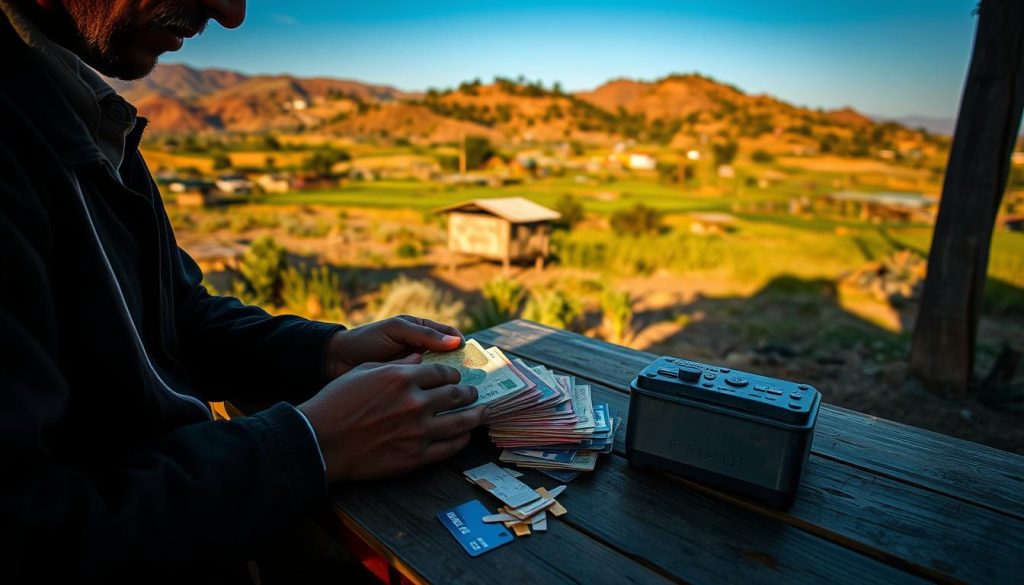
Handling Cash in Remote Areas
In many remote places, ATMs and banks are scarce. This makes carrying enough cash essential. Plan ahead by exchanging your money before you arrive. Smaller bills are especially useful for local markets and vendors.
Here are some practical tips for handling cash:
- Carry a money belt: Keep your cash safe and hidden while exploring.
- Divide your money: Store it in different places to minimize risk.
- Check exchange rates: Ensure you get the best value for your currency.
When engaging in water-based activities, like snorkeling or kayaking, leave your cash in a secure place. Many accommodations offer lockers or safes for this purpose.
Limitations of Card Usage
While credit and debit cards are convenient, their acceptance is limited in remote areas. Smaller businesses and local vendors often prefer cash. Additionally, foreign transaction fees can add up quickly.
To avoid surprises:
- Inform your bank: Let them know about your travel plans to prevent card issues.
- Carry a backup: Have a second card in case of emergencies.
- Check for fees: Some providers charge up to 18% for currency conversion.
“Preparation is the key to a stress-free journey. Knowing your payment options ensures a seamless experience.”
By following these tips, you can manage your finances effectively, whether you’re relaxing by the water or exploring a hidden place. Staying prepared allows you to focus on enjoying your adventure without financial worries.
Practical Travel Tips: Packing, Safety, and Local Customs
Traveling to a tropical destination requires thoughtful preparation to ensure a smooth and enjoyable experience. Whether you’re a first-time visitor or a seasoned traveler, knowing what to pack and how to stay safe can make all the difference. This section provides essential tips to help you navigate the tropical climate and respect local customs.
What to Pack for a Tropical Climate
Packing for a tropical destination means preparing for warm weather, occasional rain, and high humidity. Lightweight, breathable clothing is a must. Opt for fabrics like cotton or linen to stay cool during the day. Don’t forget a rain jacket or a portable umbrella for unexpected showers.
Here’s a quick checklist for your trip:
- Sunscreen and sunglasses: Protect yourself from strong UV rays.
- Comfortable footwear: Ideal for walking and exploring.
- Reusable water bottle: Stay hydrated in the heat.
- First aid kit: Include basic medications and personal prescriptions.
Weather patterns can vary throughout the year, so check the forecast before you pack. During the wet season, waterproof gear is essential. For the dry season, focus on sun protection and lightweight clothing.
Travel Safety and Cultural Etiquette
Staying safe and respecting local customs are key to a positive travel experience. Always carry a copy of your passport and important documents. Inform your bank about your travel plans to avoid issues with your cards.
When it comes to cash, smaller denominations are useful for local markets and vendors. Many places prefer cash over cards, especially in remote areas. Keep your money secure by using a money belt or dividing it between different bags.
Respect local traditions by dressing modestly, especially when visiting sacred sites. Learn a few basic phrases in the local language, like “hello” and “thank you,” to show appreciation for the culture. Being mindful of these details will help you connect with locals and enhance your trip.
“Preparation is the key to a stress-free journey. Knowing your packing essentials and cultural etiquette ensures a seamless experience.”
By following these practical tips, you’ll be well-prepared to enjoy your tropical adventure. Whether you’re exploring lush landscapes or relaxing on pristine beaches, thoughtful preparation will make your trip unforgettable.
Local Insights: Engaging with Nauruan Culture
Connecting with the local culture is one of the most rewarding parts of any trip. In this small island nation, traditions and customs are deeply rooted in history and community. By engaging with locals and learning their ways, you’ll gain a richer understanding of this unique destination.
Meeting Locals and Understanding Traditions
One of the best ways to experience the culture is by meeting the people. Nauruans are known for their warmth and hospitality. Whether you’re staying at a local accommodation or visiting a village, take the time to chat and learn about their daily lives.
Traditional practices, like fishing, are central to the island’s way of life. Many locals still rely on the ocean for food and livelihood. Joining a fishing excursion or visiting a market can give you a glimpse into this important aspect of their culture.
Respect is key when engaging with traditions. Always ask for permission before taking photos or participating in activities. This shows appreciation for their customs and helps build meaningful connections.
Useful Local Phrases and Etiquette
Learning a few basic phrases can go a long way in breaking the ice. While English is widely spoken, using local words like “Ekamawir” (hello) or “Omo” (thank you) can earn you smiles and goodwill.
Here are some tips for navigating cultural etiquette:
- Dress modestly, especially when visiting villages or sacred sites.
- Offer a small gift, like food or a token, when invited to someone’s home.
- Be mindful of local customs, such as removing shoes before entering a house.
When it comes to payments, cash is often preferred over credit cards, especially in rural areas. Carrying small bills ensures smooth transactions and shows respect for local businesses.
“The more you immerse yourself in the culture, the more you’ll appreciate the beauty of this island and its people.”
By approaching cultural experiences with openness and respect, you’ll create memories that last a lifetime. Whether you’re learning about traditional fishing methods or sharing a meal with locals, these moments will enrich your journey and deepen your connection to this incredible place.
Planning Your Itinerary: Balancing Adventure and Relaxation
Crafting the perfect itinerary is your key to unlocking the best of this destination. Whether you’re exploring historical sites or lounging on pristine beaches, a well-planned schedule ensures you make the most of your time. Here’s how to strike the right balance between adventure and relaxation.
Creating a Flexible Schedule
Flexibility is the way to go when planning your trip. Start by listing must-see attractions and activities, but leave room for spontaneity. This approach allows you to adapt to unexpected opportunities or changes in weather.
Here are some tips to help you create a balanced itinerary:
- Prioritize your interests: Focus on what excites you most, whether it’s hiking, diving, or cultural tours.
- Alternate intense and relaxed activities: Follow a busy day of exploration with a leisurely beach visit.
- Leave buffer time: Avoid over-scheduling to account for delays or last-minute plans.
Managing your time effectively ensures you experience the best of this world-class destination. By balancing adventure with downtime, you’ll return home feeling refreshed and fulfilled.
“The art of travel lies in the balance between discovery and rest. A flexible itinerary is your guide to achieving both.”
When planning your days, consider the way activities fit into your overall trip. For example, pair a morning hike with an afternoon of relaxation by the water. This rhythm keeps your energy levels steady and enhances your enjoyment.
Finally, embrace the local life by incorporating cultural experiences into your schedule. Whether it’s a traditional meal or a village visit, these moments add depth to your journey. With a thoughtful and flexible itinerary, you’ll create memories that last a lifetime.
Conclusion
This small island offers a lot of unique experiences that blend history, nature, and culture. From its vibrant reefs to its warm local hospitality, every moment here is memorable. Whether you’re exploring historical sites or enjoying fresh fish by the beach, the island’s charm is undeniable.
Practical tips like carrying cash and respecting local customs ensure a smooth trip. Plan your itinerary with flexibility to balance adventure and relaxation. This way, you’ll make the most of your time while soaking in the island’s beauty.
With its rich heritage and stunning landscapes, this destination promises a journey like no other. Start planning your trip today and get ready to create unforgettable memories.
The above is subject to change.
Check back often to TRAVEL.COM for the latest travel tips and deals.
